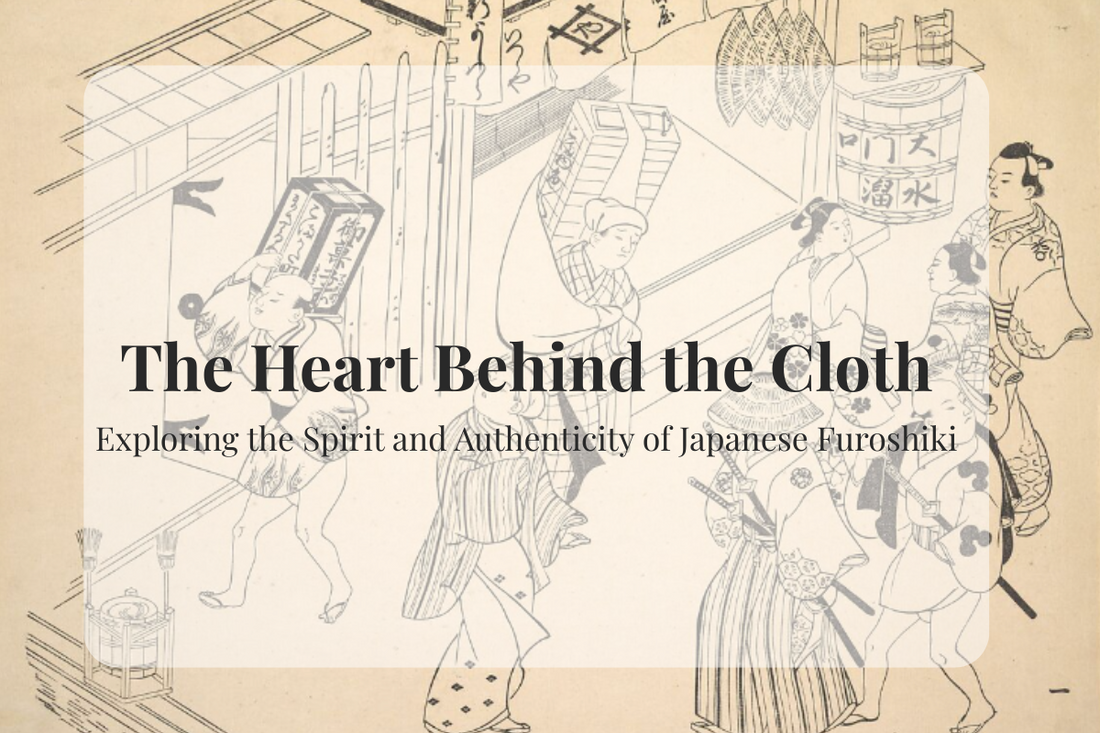
What Is Authenticity? — The Spirit of Japan Woven Into Furoshiki
Furoshiki has long been a part of Japanese daily life — a simple cloth, yet deeply rooted in our culture.
In a world overflowing with eco-friendly products, some may wonder:
“Is there really any reason to use furoshiki today?”
But there’s something beautiful in that moment when you spread out the cloth and quietly ask yourself, “How shall I wrap this?”
Each fold, each knot, carries thoughtfulness.
And in that thoughtful act, you can feel a kind of tenderness.
Furoshiki is more than just a piece of fabric.
I believe it is a vessel of the heart.
Why has it endured through time?
Furoshiki is far from the most practical or efficient item.
If you don’t know how to fold or tie it, it’s not the easiest eco bag to use.
And if it’s made of cotton, it won’t protect against the rain.
Still, it has quietly endured for generations in Japanese life.
I believe the reason lies in a uniquely Japanese sense of beauty —
the ability to find value and grace in taking that “extra step,” even when it’s inconvenient.
That mindset, that spirit, lives on in every furoshiki.
And perhaps that is why we still find it so deeply endearing.
Pride in small acts of effort
My grandmother’s house had only traditional Japanese rooms — and never a bed.
Each night, she would lay out her futon, and each morning she would fold it up and return it to the closet.
It was her daily routine.
Once, I asked her, “Wouldn’t a bed be easier?”
She smiled and replied, “As long as I can do it myself, I want to keep doing it.”
Looking back, I realize now:
She was thankful for the ability to do something a little difficult each day.
It was a quiet expression of strength, independence, and gratitude.
Furoshiki, too, requires a bit of effort.
But within that effort lives thoughtfulness, wishes, prayers — a quiet gratitude.
That’s why it has continued to be handed down through generations.
Sharing the true value of FUROSHIKI with the world
Today, furoshiki is gaining attention around the world as an eco-friendly, sustainable solution.
Many creative variations have emerged: wrinkle-free stretch fabrics, waterproof or water-repellent materials, even versions that fasten without knots.
They are, without a doubt, convenient.
And yet, in all this convenience,
I feel we may be losing something essential —
the attention to detail,
the appreciation of taking time,
the spirit of cherishing the process itself.
The surface of culture: “KIMONO,” “SUSHI,” and “RAMEN”
We see this in other cultural icons too — “KIMONO” robes, “SUSHI” in Western restaurants, or “RAMEN,” now beloved worldwide.
When I lived in Brussels, there was a ramen shop owned by a Japanese chef.
I loved going there — eating ramen while flipping through old manga, chatting in Japanese.
It felt like a little piece of home. A sanctuary.
Years later, I returned, only to find that the Japanese owner had gone.
The ramen had a different flavor.
That isn’t to say the new version was bad.
But I couldn't help wondering:
Can someone who’s never tasted authentic Japanese ramen truly recreate its essence?
Furoshiki faces a similar dilemma.
As “FUROSHIKI” becomes a global word,
the values woven into it — the sense of respect for objects, the atmosphere of the seasons, the unspoken human connection —
risk being lost in translation.
Preserving and nurturing the real meaning
That is why we at MUSUBISM want to share furoshiki not just as a product,
but as a cultural tradition — in its true and authentic form.
Our furoshiki are dyed by hand using traditional Japanese techniques,
each one carefully crafted by skilled artisans.
They are not mass-produced or inkjet printed,
and production takes time and care.
Every piece carries not only the hand of the maker,
but their philosophy and way of life —
the same quiet pride I saw in my grandmother.
More than functionality — a gift of the heart
What we hope to deliver through furoshiki is more than practicality.
It is the spirit behind it.
Furoshiki allows us to share something beyond words:
“A culture of wrapping with care”
“An invisible thread that connects hearts and people”
This is the authenticity of Japanese furoshiki.
This is its true value.
To wrap something with love,
to protect something precious,
to tie hearts across time —
That is the beauty of furoshiki.
And that is the message we hope to share with the world.
Image: A Number of People in the Street Going about Various Affairs, After Okumura Masanobu, Meiji period (1868–1912).
Courtesy of The Metropolitan Museum of Art, Public Domain.
